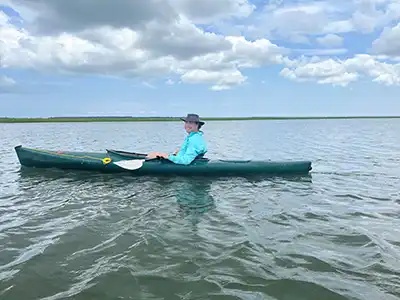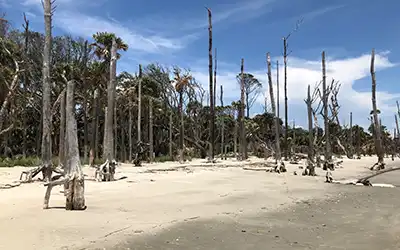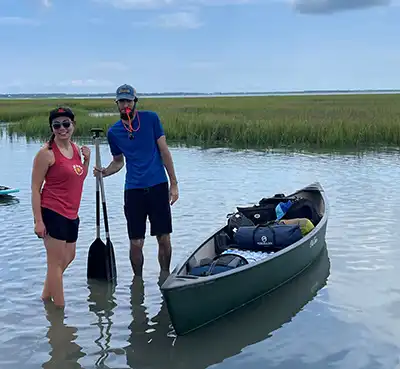
Looking for a getaway to a remote, tropical island without the hassle of planes, trains and automobiles? Did I mention that lodging is free? There’s no catch; it’s called Capers Island.
After spending a weekend camping with family on this isolated isle of paradise, sparked by some words of encouragement from my intrepid father-in-law, I was inspired to share my findings and observations on how to prepare for such an outdoorsy adventure. The following is a survival guide for first-timers like me with grand ambitions of exploration, but a lack of local knowledge and voted most likely to get stuck up a creek without a paddle. I used to be that guy but not anymore!
Note: If I can physically, mentally and emotionally endure it, then quite literally anyone can. No excuses!

Capers is an undeveloped, state-owned barrier island located just 3 miles from the mainland off Highway 17 in Awendaw and nearly 5.5 miles north of Isle of Palms, situated between Dewees Island and Bulls Island, all three islands of which are part of the 66,287-acre Cape Romain National Wildlife Refuge.
The island itself is nearly 3 miles in length and 1 mile in width. By comparison, Capers is equivalent to the length of Sullivan’s Island and about half the length of Isle of Palms. The island encompasses 850 acres of maritime uplands, 214 acres of front beach, 1,090 acres of salt marsh and more than 100 acres of brackish water impoundments, according to the South Carolina Department of Natural Resources.
There are many ways to get to Capers via the Intracoastal Waterway, but the two main routes that locals trust are via the Isle of Palms Marina and the Gadsdenville Public Boat Landing. The trip to Capers, depending on your launch site, equates to a 30-minute boat ride or an hour-and-a-half paddle. Plan your departure and arrival according to high tide (see local tide chart). Note that the island is closed to permit-less visitors one hour before sunrise and one hour after sunset.
Tip: Barrier Island Eco Tours, located at the Isle of Palms Marina, offers daily boat and kayak rentals that are relatively inexpensive with a group. There are no overnight rental options.
Island History

Originally inhabited by Native Americans, the Sewee Indians were the first explorers of its sandy shores, tracing shell middens that date back to 2000 B.C., according to the South Carolina Picture Project. In 1679, three French Huguenot brothers from Wales — Gabriel, Richard and William Capier — settled on the island and their descendants continued to occupy it until the Civil War. Over time, the island has changed names several times. It was called Sessions Island from 1675 to 1705 and then Capore Island until 1722.
In the early years of the 20th century, the Magwoods, a prominent Charleston shrimping family, owned the island. Coulter Huyler of New York, whose family was once the largest chocolate manufacturer in America, purchased the island in 1924 for $35,000. In the late 1950s, The Reynolds Corporation acquired the island as a hunting and fishing retreat. A 100-acre impoundment was built in 1961 to attract waterfowl. In 1972, the island changed hands to the Royal family. Three years later, in 1975, the State of South Carolina purchased the island for $2.65 million as part of the Heritage Trust Program.
Island Inhabitants
The semitropical terrain is riddled with stumps and branches from sun-bleached palmetto and oak trees that give it a spooky, skeletal appearance suggestive of a “boneyard beach.” Once you look past its eerie demeanor, you will discover that the island contains diverse habitats supporting abundant wildlife. You may see alligators, white-tailed deer, raccoons, loggerhead sea turtles and more nocturnal ghost crabs than your eye can count. Certain species of sharks such as bull sharks can filter the brackish waters and coexist in the environment.
The island features a nature trail called the McCaskill Trail, perfect for a laidback hike and casual birdwatching. Birds, such as herons, egrets, ibises, bitterns and other waterfowl species are common in the brackish impoundment adjacent to the trail. Each year, ospreys nest on Capers near the front beach. Eagles can also be seen soaring over the island from time to time. The creeks and marshes adjacent to Capers are alive with oysters, shrimp, hard clams, crabs and many species of fish such as sea trout, red drum, flounder, black drum, king whiting, spot, pompano and croaker.
Camping Essentials

Whether you are traveling via boat, canoe, kayak or any other watercraft, there are items you must have and others you may want to have. When the tide goes out, you will be stranded on an island. However, in case of an emergency, the cell phone service is surprisingly good.
Tip: REI, located in Indigo Square in Mount Pleasant, offers a wide variety of camping and outdoor supplies for all ages and skill levels. The prices are affordable and the staff is friendly.
The following list of supplies was provided by my camping comrades: Billy, Randy, Savy and Geoff. These are not listed in any particular order because each one is equally important for a myriad of reasons.
- Tent (with no-see-um netting because sand fleas or gnats can get through regular mosquito netting)
- Light windbreaker (in case of rain)
- Comfortable shoes
- Clothes (wet and dry)
- Sun block
- Bug spray
- Hat
- Knife
- First aid kit
- Snacks (crackers, nuts, along with meals)
- Firewood (at least 8 logs)
- Lighter
- Sleeping mat
- Light sleeping bag or blanket (in warmer weather)
- Water (gallon per person per day)
- Trash bag
- Instant coffee
- Cell phone (cordless charger and waterproof bag)
Always be sure that what you pack in is packed out. Cleanliness is close to godliness, so please respect your surroundings and above all, Mother Nature.
Rules and Regulations (per SCDNR)
This isn’t the Boy Scouts but there is a code of conduct to follow while inhabiting the island. The following are not requests but demands and violators will be prosecuted. You will be shunned and exiled. In all seriousness, don’t ruin the fun for everyone.
- Overnight camping on Capers Island is by permit only. Permit may be obtained from the DNR Charleston office. No more than 40 people will be allowed to camp per night. These 40 people may be divided into no more than 20 different groups.
- Permits will be issued on a first come first served basis by contacting Kathryn Johnson at (843)-953-9360 during regular business hours Monday-Friday 8:30 a.m. to 5 p.m.
- Campsites will be occupied on a first come first served basis.
- Permits are not required for day use.
- Persons without permits must be off the island by one hour after sunset.
- Dogs are allowed on the southern beaches of Capers Island.
- Dogs are not allowed in the impoundment area.
- Dogs are not allowed on the northern beaches of Capers Island between April 1 and Aug. 31. Areas closed to dogs are posted by the Department.
- Dogs restrained by a leash or similar device are allowed in the designated area on Price’s Inlet.
- No trash is to be placed in any fire or buried.
- Department maintenance facilities on the island are not open to the public.
- No crab or fish pots or traps are allowed in impoundments.
- No motorized vehicles, non-motorized vehicles, off road vehicles or all-terrain vehicles are allowed on Capers Island.
- No fishing is allowed from the impoundment tide gate.
- No hunting is allowed on property.
In retrospect, the best way to approach your first or next camping trip to Capers is to hope for the best but prepare for the worst of conditions. In the words of my wife and muse for everything, “Do it afraid!”
P.S. Thanks to Scott and Anne for letting me borrow their canoe and my sincerest apologies to their neighbor who asked to use it. I hope this article inspires your next family trip. Bon Voyage!
By Zach Giroux

Leave a Reply